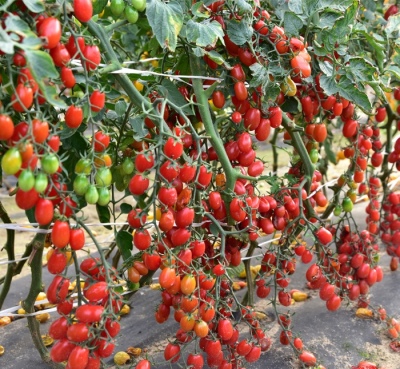
- Category: hybrid
- Growth type: semi-determinant
- Appointment: universal
- Ripening period: mid-season
- Ripening time, days: 95
- Growing conditions: for open ground, for film greenhouses, for closed ground, for greenhouses
- Transportability: high
- Bush size: medium-sized
- Bush height, cm: 90-150
- Foliage: moderate
Red Date Tomato was bred by Russian breeders-practitioners by hybridizing a common tomato and cherry tomato. The fruits of this hybrid are in most cases used for decorating banquet dishes, as well as for vegetarian and children's menus. The fruits of this variety are popular and always in demand among lovers of small-fruited tomatoes.
Description of the variety
The red date tomato belongs to the F1 hybrids family and is semi-determinant. The growth of the central shoot is completed in the phase of emergence 11-13 of the vegetative bud. The height of the bushes of this variety ranges from 90 to 150 cm. The plant has a proportional amount of deciduous mass and side shoots. From 6 to 8 fruits are formed on one bunch. The hybrid is suitable for growing both in covered greenhouse gardens and greenhouses, and in street beds, but in areas with mild climatic conditions.
Advantages:
long-term fruiting;
wide range of applications;
high percentage of germination;
a high degree of invulnerability to negative environmental factors;
uniform ripening of fruits;
resistance to the most common diseases;
transportability;
undemanding care;
good keeping quality.
Disadvantages:
the need to form and tie up a bush;
late ripening.
The main qualities of the fruit
The fruits of the red date tomato have an elongated ovoid configuration with a protruding spout. Ripe tomatoes have a deep red color and look spectacular and aesthetically pleasing. A distinctive feature is the small seed chambers. The crop has a high degree of keeping quality and is suitable for long-term transportation.
Taste characteristics
The taste qualities of this variety of Solanaceae are rich and sweet. The fruits have a light fruity flavor that is their characteristic feature. The soft subcutaneous part of a tomato has a dense, juicy and sugary structure. Average weight of one fruit is 20 g. This variety is suitable for both pickling and pickling. Canned fruits retain their attractive appearance for a long time without cracks and dents.
Ripening and fruiting
The tomato has a medium late ripening period. A distinctive feature is a long fruiting period. The fruit ripens in July - October.
Yield
The yield of hybrid tomato Red dates from one bush can reach 1500 g. From a plot of 1 m2, you can collect up to 6 kg of fruits. Advantages - the ability to harvest in whole bunches.
The disadvantage is a significant decrease in yield at low temperatures.
The timing of planting seedlings and planting in the ground
The cultivation of this variety is carried out by the seedling method. Sowing date of seed is the beginning of March. The optimal soil substrate is a mixture of sand, peat, ordinary earth, wood ash and combined mineral dressings. Sowing depth of seeds is not more than 1 cm. The optimum temperature is +20 degrees. Germination can be increased due to the high level of illumination and the creation of a greenhouse effect by covering the planting containers with foil. After the appearance of 2 sheets, it is imperative to carry out a pick.The variety is responsive to complex mineral and organic fertilizers.
The term for planting seedlings in open ground is the end of May. During the planting period, the average daily temperature should not fall below +19 degrees.

Growing tomato seedlings is an extremely important process, because it largely depends on whether the gardener will be able to harvest at all. All aspects must be taken into account, from seedbed preparation to planting in the ground.
Landing scheme
The landing pattern is classic. There should not be more than 3-4 plants per 1 m2.

Growing and care
The planted plants require regular watering with the addition of mineral and organic fertilizers. For one bush, 3 liters of settled water is enough. It is strictly forbidden to water with cold water. Watering frequency is 2-3 times a week. To enrich the root system with oxygen and accelerate plant growth, it is necessary to regularly loosen the soil, and mulching will help to maintain the optimal moisture level.
A hybrid requires an obligatory garter to the supports and regular pinning.




A plant needs different micronutrients at each stage of growth. All fertilizers can be divided into two groups: mineral and organic. Folk remedies are often used: iodine, yeast, bird droppings, eggshells.
It is important to observe the rate and period of feeding. This also applies to folk remedies and organic fertilizers.
Disease and pest resistance
The red date tomato has a high level of resistance to various types of diseases. However, to prevent the appearance of diseases such as late blight, gray rot and white rot, mosaic virus, fusarium wilting, plants must be regularly treated with special preparations. It is strictly forbidden to carry out processing after the appearance of the first inflorescences.
Regular mulching and loosening of the root zone will help prevent the appearance of aphids, thrips, whiteflies, scoops and naked slugs.


Resistant to adverse weather conditions
This hybrid has a high level of resistance to fungal and bacterial diseases during unstable and unfavorable weather conditions. However, it should be remembered that sharp temperature fluctuations can provoke a low level of pollination, which will significantly reduce the number of fruit ovaries.

























































































